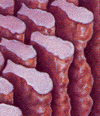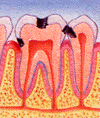Tooth enamel is hard and porous. It consists of many closely-packed rods made of minerals. When you eat, acid forms on the outside of the tooth and seeps into the enamel’s pores. This demineralization process can produce a weak spot in the tooth’s surface. If unchecked, the enamel can decay and create a cavity.
Fluoride helps prevent tooth decay by slowing the breakdown of enamel and speeding up the natural remineralization process. These microscopic views of the tooth’s chewing surface show how fluoride works:
 |
Healthy tooth enamel rods before acid’s onslaught. |
 |
Enamel rods demineralized, or broken down, by acid. |
 |
Enamel rods remineralized, or rebuilt, by fluoride and the minerals in saliva. |
Common sources of fluoride are fluoridated drinking water, toothpaste, and mouth rinse. Inform your dentist if your drinking water is not fluoridated. High concentration fluoride gels, mouth rinses, drops, and tablets are available by prescription.
When your dentist detects a weak spot on your tooth, at-home fluoride treatments may be recommended to reverse the decay process. If the weak spot is left unchecked, a cavity may form, necessitating a filling. If decay is allowed to spread, it may penetrate the root and enter the pulp (nerve) chamber, causing an abscess and requiring root canal treatment.
| Tooth decay often begins on biting surfaces, between the teeth, and on exposed roots. |  |
| Untreated, the cavity becomes larger. |  |
| Decay spreads beneath the enamel and can destroy the tooth structure. |  |
| Decay enters the pulp and an abscess may occur. |  |
Use of fluoridated toothpaste can help prevent tooth decay at its early stage.
Be sure to follow the special home care instructions provided by your dental professional.
